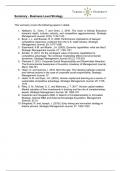Samenvatting
Complete Course Summary - Business Level Strategy (2023)
- Instelling
- Tilburg University (UVT)
This summary covers all the obligated journal articles, lecture material and contains additional notes for the course Business Level Strategy for the Master Strategic Management. My exam result: 8,6 / 10
[Meer zien]





